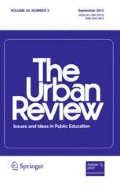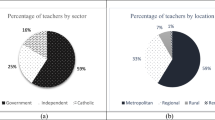Abstract
American Indian students are disproportionately represented in school discipline referrals (ODRs) and administrative outcomes across general school populations (Brown and DiTillio in J Educ Learn 2(4):47–59, 2013; Whitford and Levine-Donnerstein in Behav Disord 39(2), 2014). The purpose of this study was to examine the ODRs and administrative outcomes of 1612 students in special education, with particular attention to American Indian students (29.2% of the sample). Results indicated, although proportionally referred to school administration for disciplinary action, American Indian students in special education were more likely to be given an out-of-school suspension and/or expulsion, than both White and Hispanic/Latino students in special education, for the same identifying behaviors. Implications for improved practice are provided.

Similar content being viewed by others
References
American Psychological Association Zero Tolerance Task Force. (2008). Are zero tolerance policies effective in the schools? American Psychologist, 63(9), 852–862. doi:10.1037/0003-066X.63.9.852.
Arizona Department of Education (ADE). (2012). AzSAFE Project. Retrieved from http://www.azed.gov.
Aud, S., Fox, M. A., & KewalRamani, A. (2010). Status and trends in the education of racial and ethnic groups (NCES 2010-015). U.S. Department of Education, National Center for Education Statistics. Washington, D.C.: U.S. Government Printing Office.
Basch, C. E. (2011). Teen pregnancy and the achievement gap among urban minority youth. Journal of School Health, 81(10), 614–618. doi:10.1111/j.1746-1561.2011.00635.x.
Boroughs, M., Massey, O. T., & Armstrong, K. H. (2005). Socioeconomic status and behavior problems. Journal of School Violence, 4(4), 31–46. doi:10.1300/J202v04n04_03.
Brown, C. A., & DiTillio, C. (2013). Discipline disproportionality among Hispanic and American Indian students: Expanding the discourse in U.S. research. Journal of Education and Learning, 2(4), 47–59. Retrieved from http://www.ccsenet.org.
Butterfield, R. (2003). Strengthening partnerships for native American students. Summary report. Council of Chief State School Officers. Denver, CO. April 9–11, 2003.
Center for Behavioral Health Statistics and Quality. (2013). The NSDUH report: Substance use among 12th grade aged youth by dropout status. Retrieved from http://archive.samhsa.gov/data/2k13/NSDUH036/SR036SubstanceUseDropouts.htm.
Children’s Defense Fund (CDF). (1975). School suspensions: Are they helping children? Cambridge: MA: Washington Research Project.
Data Accountability Center (DAC). (2013). IDEA, part B discipline. Rockville, MD: Westat.
DeVoe, J. F., & Darling-Churchill, K. E. (2008). Status and trends in the education of American Indians and Alaska Natives: 2008 (NCES 2008-084). Washington, DC: National Center for Education Statistics, Institute of Education Sciences, U.S. Department of Education.
Faircloth, S. C., & Tippeconnic, III, J. W. (2010). The dropout/graduation rate crisis among American Indian and Alaska native students: Failure to respond places the future of native peoples at risk. Los Angeles, CA: The Civil Rights Project/Proyecto Derechos Civiles at UCLA. http://www.civilrightsproject.ucla.edu.
Fallon, L. M., O’Keeffe, B. V., & Sugai, G. (2012). Consideration of culture and context in school-wide positive behavior support: A review of current literature. Journal of Positive Behavior Interventions, 14(4), 209–219. doi:10.1177/1098300712442242.
Groark, M., & Garin, G. (2012). Skipping to nowhere. Hart Research Team. Retrieved from http://www.attendanceworks.org/wordpress/wp-content/uploads/2013/10/Skipping-to-Nowhere-August-2012.pdf.
Hammond, H., Dupoux, E., & Ingalls, L. (2004). Culturally relevant classroom management strategies for American Indian students. Rural Special Education Quarterly, 23(4), 3–9. Retrieved from http://acres-sped.org/journal.
Horner, R. H., Sugai, G., Todd, A., & Lewis-Palmer, T. (2005). School-wide positive behavior support. In L. Bambara & L. Kern (Eds.), Individualized supports for students with problem behaviors: Designing positive behavior plans (pp. 359–390). New York: Guilford Press.
Kaufman, J. S., Jaser, S. S., Vaughan, E. L., Reynolds, J. S., DiDonato, J., Bernard, S. N., et al. (2010). Patterns in office referral data by grade, race/ethnicity, and gender. Journal of Positive Behavior Interventions, 12(1), 44–54. doi:10.1177/1098300708329710.
Ladson-Billings, G. (1995). Toward a theory of culturally relevant pedagogy. American Educational Research Journal, 32(3), 465–491.
Ladson-Billings, G. (2014). Culturally relevant pedagogy 2.0: a.k.a. the remix. Harvard Educational Review, 84, 74–84.
Lomawaima, K. T., & McCarty, T. L. (2006). “To remain an Indian”: Lessons in democracy from a century of native American schooling. New York, NY: Teachers College Press.
McCarty, T. L., & Lee, T. S. (2014). Critical culturally sustaining/revitalizing pedagogy and indigenous education sovereignty. Harvard Educational Review, 84, 101–124.
Morgan, H. (2010). Improving schooling for cultural minorities: The right teaching styles can make a big difference. Educational Horizons, 88(2), 114–120. Retrieved from http://pilambda.org/benefits/publications/educational-horizons/.
Paris, D. (2012). Culturally sustaining pedagogy: A needed change in stance, terminology, and practice. Educational Researcher, 41(3), 93–97.
Paris, D., & Alim, H. S. (2014). What are we seeking to sustain through culturally sustaining pedagogy? A loving critique forward. Harvard Educational Review, 84, 85–100.
Pewewardy, C. (2002). Learning styles of American Indian/Alaska native students: A review of the literature and implications for practice. Journal of American Indian Education, 41(3), 22–56. Retrieved from http://jaie.asu.edu/.
Scott, T. B., & Barrett, S. B. (2004). Using staff and student time engaged in disciplinary procedure to evaluate the impact of school-wide PBS. Journal of Positive Behavior Interventions, 6(1), 21–27. doi:10.1177/10983007040060010401.
Skiba, R. J., Horner, R. H., Chung, C. G., Rausch, M. K., May, S. L., & Tobin, T. (2011). Race is not neutral: A national investigation of African American and Latino disproportionality in school discipline. School Psychology Review, 40(1), 85–107.
Skiba, R. J., & Peterson, R. L. (2000). School discipline at a crossroads: From zero tolerance to early response. Exceptional Children, 66(3), 335–347.
Sprague, J. R., Vincent, C. G., Tobin, T. J., & Pavel, M. (2013). Preventing disciplinary exclusions of students from American Indian/Alaska Native backgrounds. In J. S. Kaye (Chair). Summit conducted at the national leadership summit on school-justice partnerships: Keeping kids in school and out of court, New York City. Retrieved from http://school-justicesummit.org/papers/paper_6.cfm.
Sugai, G., O’Keeffe, B. V., & Fallon, L. M. (2012). A contextual consideration of culture and school-wide positive behavior support. Journal of Positive Behavior Interventions, 14(4), 197–208. doi:10.1177/1098300711426334.
Tenenbaum, H. R., & Ruck, M. D. (2007). Are teachers’ expectations different for racial minority than for European American students? A meta-analysis. Journal of Educational Psychology, 99(2), 253–273. doi:10.1037/0022-0663.99.2.253.
U. S. Department of Education (USDOE). (2015). White House initiative on American Indian and Alaska Native education: School environment listening sessions. Retrieved from https://sites.ed.gov/whiaiane/files/2015/10/school-environment-listening-sessions-final-report.pdf.
U. S. Census Bureau. (2010). American FactFinder. Retrieved from http://quickfacts.census.gov.
Vincent, C. G., Sprague, J. R., & Tobin, T. J. (2012). Exclusionary discipline practices across students’ racial/ethnic backgrounds and disability status: Findings from the Pacific Northwest. Education and Treatment of Children, 35(4), 585–601.
Wald, J., & Kurlaender, M. (2003). Connected in Seattle? An exploratory study of student perceptions of discipline and attachments to teachers. New Directions for Youth Development, 2003(99), 35–54. doi:10.1002/yd.53.
Wallace, J. M., Goodkind, S., Wallace, C. M., & Bachman, J. G. (2008). Racial, ethnic, and gender difference in school discipline among U.S. high school students: 1991–2005. The Negro Educational Review, 59(1–2), 47–62.
Weinstein, C., Tomlinson-Clarke, S., & Curran, M. (2004). Toward a conception of culturally responsive classroom management. Journal of Teacher Education, 55(1), 25–38.
Whitford, D. K., & Levine-Donnerstein, D. (2014). Office disciplinary referral patterns of American Indian students from elementary school through high school. Behavioral Disorders, 39(2), 78–88.
Zhang, D., Katsiyannis, A., & Herbst, M. (2004). Disciplinary exclusions in special education: A 4-year analysis. Behavioral Disorders, 29(4), 337–347.
Author information
Authors and Affiliations
Corresponding author
Rights and permissions
About this article
Cite this article
Whitford, D.K. School Discipline Disproportionality: American Indian Students in Special Education. Urban Rev 49, 693–706 (2017). https://doi.org/10.1007/s11256-017-0417-x
Published:
Issue Date:
DOI: https://doi.org/10.1007/s11256-017-0417-x




